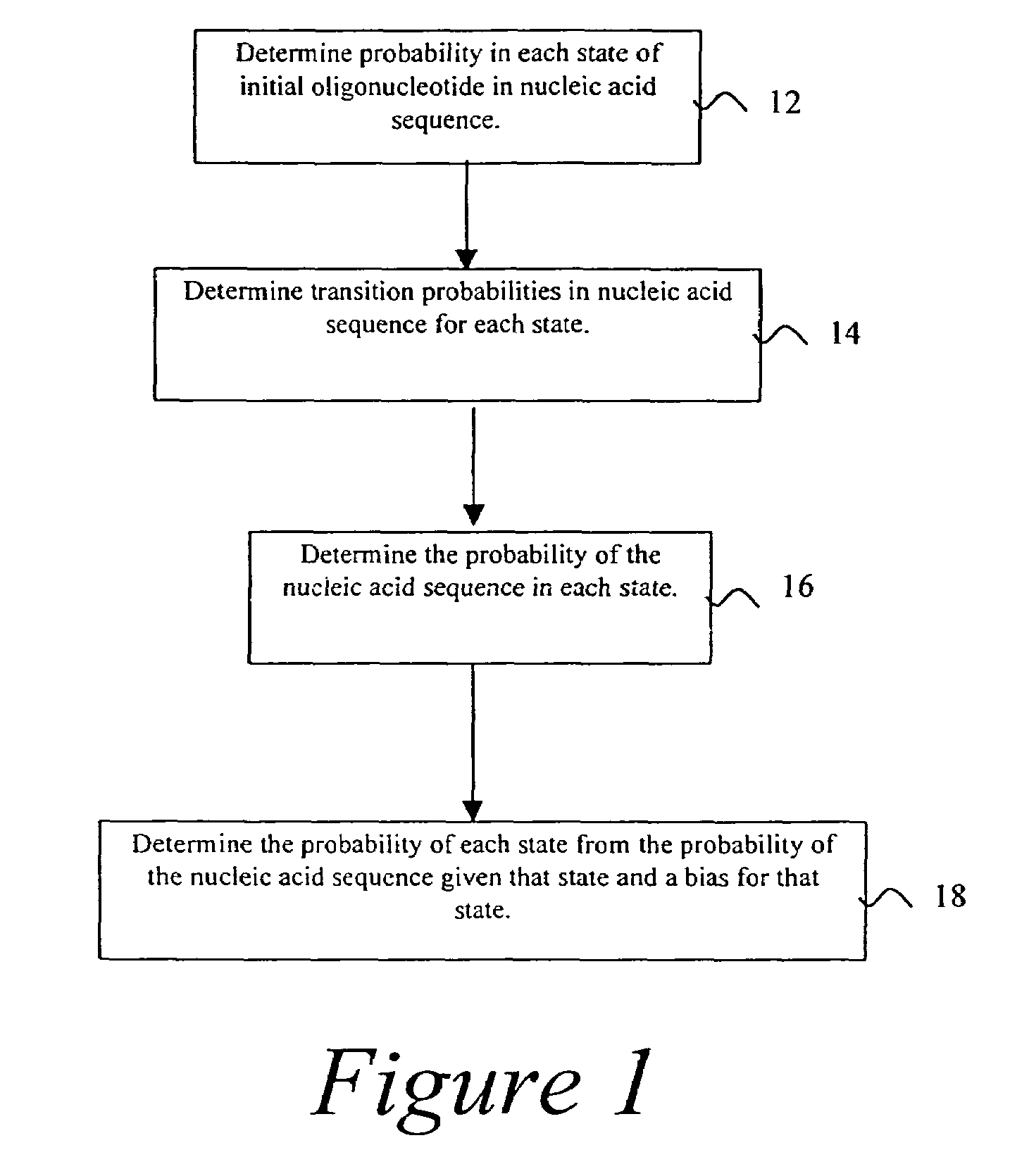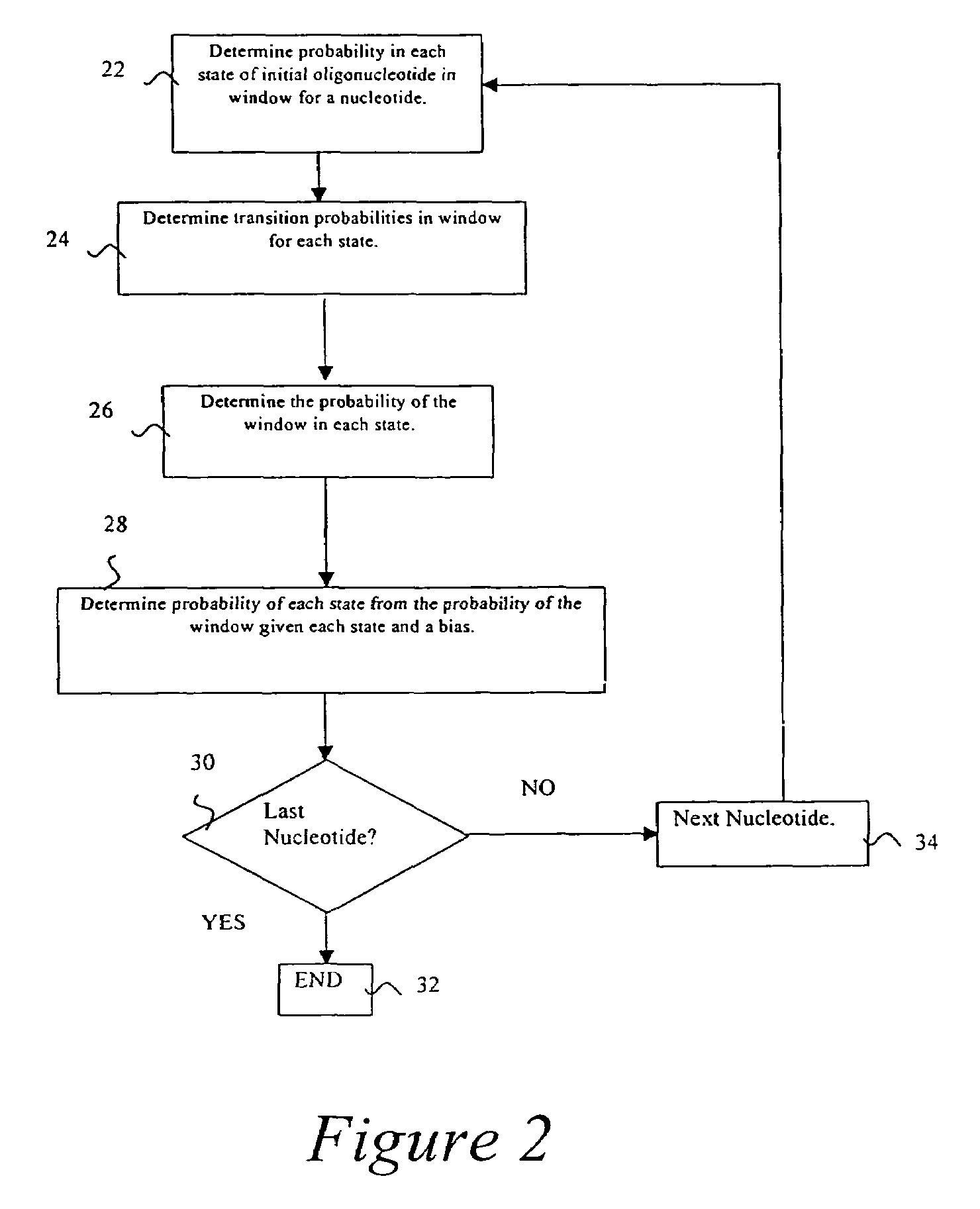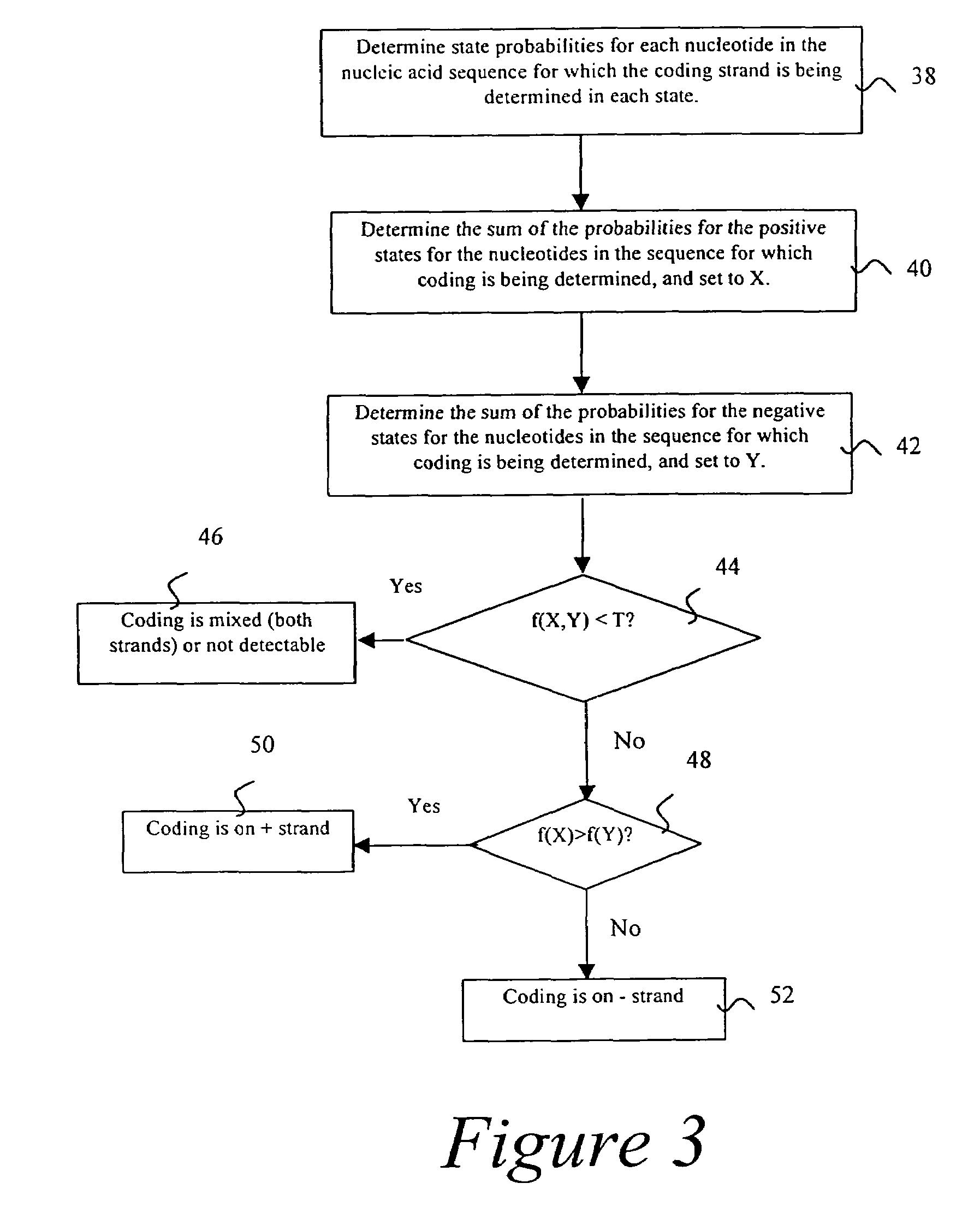Probabilistic method for determining nucleic acid coding features
a probabilistic analysis and nucleic acid technology, applied in the field of bioinformatics, can solve the problems of time-consuming and costly, content-based searches have limited desirability, and are inefficient to run
- Summary
- Abstract
- Description
- Claims
- Application Information
AI Technical Summary
Benefits of technology
Problems solved by technology
Method used
Image
Examples
example 1
[0168]Referring now to FIGS. 10a, 10b, and 10c, examples of biasing are shown. FIG. 10a shows a portion of genomic DNA 300. Aligned with the genomic DNA 300 is an expressed sequence tag (EST) 302. The EST 302 comprises coding regions 304 and noncoding regions 306. In FIG. 10b a window 308 of nucleotides is examined. The window 308 is positioned on the genomic DNA 300 that corresponds to a known coding region 304 on the EST 302. The a priori probability of coding is said to be 100% over that window 308 and a bias is applied accordingly. In FIG. 10c, a different window 310 straddles the intron-exon boundary, and the a priori probability of coding is said to be 100% for the nucleotides in the window 310 that correspond to the coding region 304 of the EST 302, while the a priori probability of coding is said to be 0% for the nucleotides in the window 310 that correspond to the noncoding region 306 of the EST 302.
[0169]Bias is applied to the two different situations shown in FIGS. 10b an...
example 2
[0195]The following example illustrates the computations involved in probability calculations for a sequence with and without a bias applied. The nucleotide sequence GATGACATT is used in this example for clarity and simplicity, but it is understood that longer sequences as indicated above can be used. Further, for this example, a zero order inhomogeneous Markov model is used. In this model, the initial probabilities are all 1 and each event is independent of that which precedes it (a1 . . . ak→ak+1 becomes N→a1 because k is zero). Models of higher order can be used, as described above.
[0196]Accordingly, the following hypothetical table of probabilities is used:
[0197]
Direct (+)Reverse (−)1+2+3+1−2−3−N±T0.130.270.130.100.250.210.20C0.280.260.390.390.210.380.30A0.210.260.090.130.270.130.21G0.380.210.390.380.260.280.29
[0198]Without a bias function ø(σ) to incorporate known information in the calculations, P(S|σ) can be calculated for the zero order case for the sequence GATGACATT accord...
example 3
[0213]The following is a copy of the output of a program implementing the method described above with and without a bias function. The following sequence is a genomic sample from the organism Arabidopsis thaliana, landsberg.
[0214]
TACTCAAAAATATATTCCATGCTTAATTAGGCCGGATTCGCGGTGACGATGCACCAAGAGCGGTTTTTCCGA(SEQ. ID. NO. 1)GCATTGTAGGCCGTCCTCGCCACACCGGTGTGATGGTTGGGATGGGACAAAAGGATGCTTATGTTGGAGACGAGGCTCAATCAAAACGTGGTATCTTGACTCTGAAGTACCCAATTGAGCATGGAATTGTTAATAATTGGGATGACATGGAGAAGATTTGGCATCACACTTTCTACAATGAGCTTCGTGTTGCCCCTGAAGAACATCCGGTTCTCTTGACCGAAGCTCCTCTCAATCCGAAAGCTAACCGTGAGAAGATGACTCAGATCATGTTTGAGACATTCAATACTCCTGCTATGTATGTTGCCATTCAAGCTGTTCTCTCACTCTATGCCAGTGGCCGTACTACTGGTCAGTACATTACTACATTCTTTTTATACCGTTTGGTTGAAATAAAATTCGGTTTGGTTCGATTCGAGTTTGCTCTCATTATTTTTATTTTGTTGGTTAGGTATTGTTTTGGACTCCGGAGATGGTGTGAGCCACACGGTACCAATCTACGAGGGTTATGCACTTCCACACGCAATCCTGCGTCTTGATCTTGCAGGTCGTGACCTAACCGACCACCTTATGAAAATCCTGACAGAGCGTGGTTACTCTTTCACCACAACTGCTGAGCGTGAGATTGTTAGAGACATGAAGGAGAAGCTCTCTTACATTGCCTTGGACTTTGAACAAG...
PUM
 Login to View More
Login to View More Abstract
Description
Claims
Application Information
 Login to View More
Login to View More - R&D
- Intellectual Property
- Life Sciences
- Materials
- Tech Scout
- Unparalleled Data Quality
- Higher Quality Content
- 60% Fewer Hallucinations
Browse by: Latest US Patents, China's latest patents, Technical Efficacy Thesaurus, Application Domain, Technology Topic, Popular Technical Reports.
© 2025 PatSnap. All rights reserved.Legal|Privacy policy|Modern Slavery Act Transparency Statement|Sitemap|About US| Contact US: help@patsnap.com



